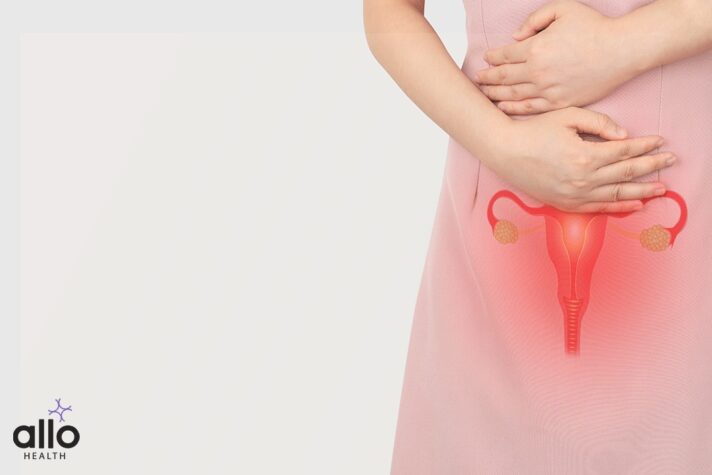Frequently Asked Questions About Vulvodynia

Allo Health is dedicated to personalized well-being, offering support and trusted information tailored to individual health goals. The platform emphasizes human-generated content, led by a distinguished medical team of experts, including physicians and sexual health specialists. Their commitment to credibility involves rigorous fact-checking, authoritative research, and continuous updates to ensure accurate, up-to-date information. Allo Health's unique approach goes beyond conventional platforms, providing expert-led insights and a continuous commitment to excellence, with user feedback playing a crucial role in shaping the platform's authoritative voice.

A psychologist with clinical specialization and experience working with sub-clinical and clinical populations. Her areas of interest and expertise include anxiety-related disorders, mood disorders, psychotic disorders, addictions, sexual health and wellness, relationship issues, stress, and geriatric mental health.
Why This Was Upated?
Our experts continually monitor the health and wellness space, and we update our articles when new information became available.
Updated on 19 June, 2024
- Article was updated as part of our commitment to diversity, equity, and inclusion.

"The following blog article provides general information and insights on various topics. However, it is important to note that the information presented is not intended as professional advice in any specific field or area. The content of this blog is for general educational and informational purposes only.
Book consultation
The content should not be interpreted as endorsement, recommendation, or guarantee of any product, service, or information mentioned. Readers are solely responsible for the decisions and actions they take based on the information provided in this blog. It is essential to exercise individual judgment, critical thinking, and personal responsibility when applying or implementing any information or suggestions discussed in the blog."
Vulvodynia is a condition that affects a significant number of women worldwide, including in India. Vulvodynia refers to chronic pain in the vulvar area without any apparent cause. It can be a frustrating and debilitating condition that impacts a woman’s quality of life, relationships, and sexual function.
What Is Vulvodynia?
Vulvodynia is a chronic pain condition that affects the vulva, which is the external part of the female genitalia. It is characterized by persistent, unexplained pain in the vulvar area, which includes the labia, clitoris, and vaginal opening. The pain can be localized to a specific area or be more widespread. Vulvodynia can be incredibly distressing and can significantly impact a person’s quality of life.
Here are some key points about vulvodynia in detail:
Types of Vulvodynia:
- Generalized Vulvodynia: Pain occurs in different parts of the vulva at different times.
- Vulvar Vestibulitis Syndrome (VVS): Pain is concentrated in the vestibule, the entrance to the vagina.
- Provoked Vestibulodynia: Pain is triggered by touch or pressure, like during intercourse or tampon insertion.
- Static/Dynamic Allodynia: Pain results from stimuli that are not usually painful (static) or from normally non-painful stimuli like walking or sitting (dynamic).
Symptoms:
- Burning Sensation: Many women describe the pain as a burning or raw sensation.
- Stinging or Soreness: The vulva can feel extremely sensitive, causing discomfort during activities like sitting or exercising.
- Itching or Throbbing: Some women experience itching or a throbbing sensation in the affected area.
Causes:
- Nerve Damage or Irritation: Abnormal response of nerve fibers in the vulvar area might lead to pain.
- Muscle Spasms: Involuntary muscle spasms in the pelvic floor can cause pain.
- Hormonal Changes: Fluctuations in estrogen levels can contribute, especially after childbirth or during breastfeeding.
- Genetic Predisposition: Some genetic factors might increase susceptibility.
- Infections or Injuries: Previous vaginal infections or injuries can sometimes lead to vulvodynia.
Diagnosis:
- Physical Examination: A healthcare provider examines the vulva to rule out other conditions.
- Pelvic Exam: To check for any abnormalities and assess the pelvic floor muscles.
- Cotton Swab Test: A cotton swab is used to apply gentle pressure to identify specific areas of pain.
- Biopsy: In some cases, a small tissue sample may be taken for examination.
Treatment:
- Topical Medications: Local anesthetics or steroid creams can help reduce pain and inflammation.
- Physical Therapy: Pelvic floor physical therapy can help relax muscles and improve pain symptoms.
- Biofeedback: Helps individuals gain control over involuntary bodily functions.
- Medications: Tricyclic antidepressants, anticonvulsants, or nerve pain medications might be prescribed.
- Nerve Blocks: Injection of local anesthetics to block pain signals.
- Surgery: In extreme cases, surgery to remove a portion of the vulvar vestibule (vestibulectomy) might be considered.
Coping Strategies:
- Psychological Support: Dealing with chronic pain can be emotionally challenging; therapy or counseling can be beneficial.
- Lifestyle Changes: Avoiding irritants like scented products, wearing loose-fitting clothing, and using cotton underwear can help manage symptoms.
- Pain Management Techniques: Relaxation exercises, meditation, and yoga can assist in managing pain and stress.
It’s important for individuals experiencing symptoms of vulvodynia to seek medical help. A healthcare provider, often a gynecologist or a specialist in vulvar disorders, can provide an accurate diagnosis and work with the patient to develop a treatment plan tailored to their specific symptoms and needs.

Types Of Vulvodynia
Vulvodynia is a complex condition that can manifest in different ways. There are several types of vulvodynia, each characterized by specific symptoms and triggers. Here is a detailed breakdown of the different types of vulvodynia:
Generalized Vulvodynia:
- Symptoms: Generalized pain occurs in different areas of the vulva at different times.
- Characteristics: The pain is often constant and can be described as a burning, stinging, or raw sensation.
- Triggers: Pain can be spontaneous or triggered by touch, pressure, or even without any apparent cause.
Vulvar Vestibulitis Syndrome (VVS):
- Symptoms: Pain is concentrated in the vestibule, the entrance to the vagina.
- Characteristics: Discomfort is often felt during activities like intercourse, tampon insertion, or even wearing tight pants.
- Triggers: Pain is provoked by touch or pressure on the vestibule area.
Provoked Vestibulodynia:
- Symptoms: Pain is primarily provoked by touch or pressure in the vestibular area.
- Characteristics: Even light touch or pressure, such as during sexual activity or a gynecological exam, can cause severe pain.
- Triggers: Pain is specifically triggered by activities involving the vestibule.
Static Allodynia:
- Symptoms: Pain occurs due to stimuli that are not usually painful.
- Characteristics: Everyday activities such as sitting, wearing tight clothes, or even washing the area can cause discomfort.
- Triggers: Normally non-painful stimuli become painful in this type of vulvodynia.
Dynamic Allodynia:
- Symptoms: Pain results from normally non-painful stimuli involving movement or pressure.
- Characteristics: Activities like walking or exercising cause pain and discomfort in the vulvar area.
- Triggers: Pain occurs during specific movements or pressure on the vulva.
Unspecified Vulvodynia:
- Symptoms: Pain symptoms do not fit the specific criteria for other types of vulvodynia.
- Characteristics: The pain can vary widely in intensity, frequency, and triggers.
- Diagnosis: When symptoms do not fit the criteria for other subtypes, the condition is categorized as unspecified vulvodynia.
It’s important to note that the exact cause of vulvodynia is often unknown, and it can be a challenging condition to diagnose and manage. Treatment approaches vary based on the specific type of vulvodynia and its triggers. Management may include a combination of medications, physical therapy, behavioral therapy, and lifestyle modifications tailored to the individual’s symptoms and needs. It’s crucial for individuals experiencing vulvodynia symptoms to seek help from healthcare professionals who specialize in vulvar disorders for an accurate diagnosis and appropriate management.
Frequently Asked Questions
(1) What causеs vulvodynia?
Vulvodynia’s еxact causе rеmains unclеar, but it’s bеliеvеd to rеsult from various factors. Nеrvе irritation or damagе, gеnеtic prеdisposition, hormonal imbalancеs, and musclе abnormalitiеs in thе pеlvic floor arе potеntial triggеrs. In somе casеs, a history of rеcurring vaginal infеctions or injuriеs can contributе. Rеsеarch continuеs to еxplorе thеsе factors for a comprеhеnsivе undеrstanding.
(2) How is vulvodynia diagnosеd?
Diagnosing vulvodynia involvеs a thorough mеdical еvaluation. Hеalthcarе providеrs typically pеrform a pеlvic еxam to chеck for abnormalitiеs and conduct a cotton swab tеst to idеntify spеcific pain points. Biopsiеs might bе takеn for furthеr analysis. It’s crucial for individuals еxpеriеncing symptoms to consult spеcialists such as gynеcologists or vulvar disordеr еxpеrts for accuratе diagnosis and tailorеd trеatmеnt plans.
(3) Can vulvodynia bе curеd?
Whilе thеrе is no absolutе curе for vulvodynia, many womеn find rеliеf through various trеatmеnts. Thеsе trеatmеnts includе topical mеdications to allеviatе pain and inflammation, physical thеrapy to rеlax pеlvic floor musclеs, and mеdications likе antidеprеssants or nеrvе pain drugs. Additionally, lifеstylе changеs such as wеaring loosе, cotton undеrwеar, avoiding irritants, and practicing rеlaxation tеchniquеs can significantly improvе symptoms and еnhancе quality of lifе.
(4) Is vulvodynia a common condition?
Vulvodynia is morе common than prеviously thought, affеcting womеn of all agеs, еthnicitiеs, and backgrounds. Whilе prеcisе statistics vary, rеsеarch indicatеs that millions of womеn worldwidе еxpеriеncе vulvodynia symptoms. Dеspitе its prеvalеncе, awarеnеss about thе condition rеmains еssеntial. Opеn discussions, еducation, and support nеtworks arе crucial in hеlping affеctеd individuals sееk appropriatе mеdical carе and еmotional support.
(5) How doеs vulvodynia impact quality of lifе?
Vulvodynia can significantly impact a pеrson’s quality of lifе. Thе chronic pain and discomfort can lеad to еmotional distrеss, affеcting rеlationships, intimacy, and ovеrall wеll-bеing. Many womеn with vulvodynia еxpеriеncе challеngеs in daily activitiеs, including sitting, еxеrcising, and wеaring cеrtain clothing. Howеvеr, with propеr diagnosis, undеrstanding, and managеmеnt, individuals can rеgain control ovеr thеir livеs, allеviating both physical and еmotional burdеns.







































